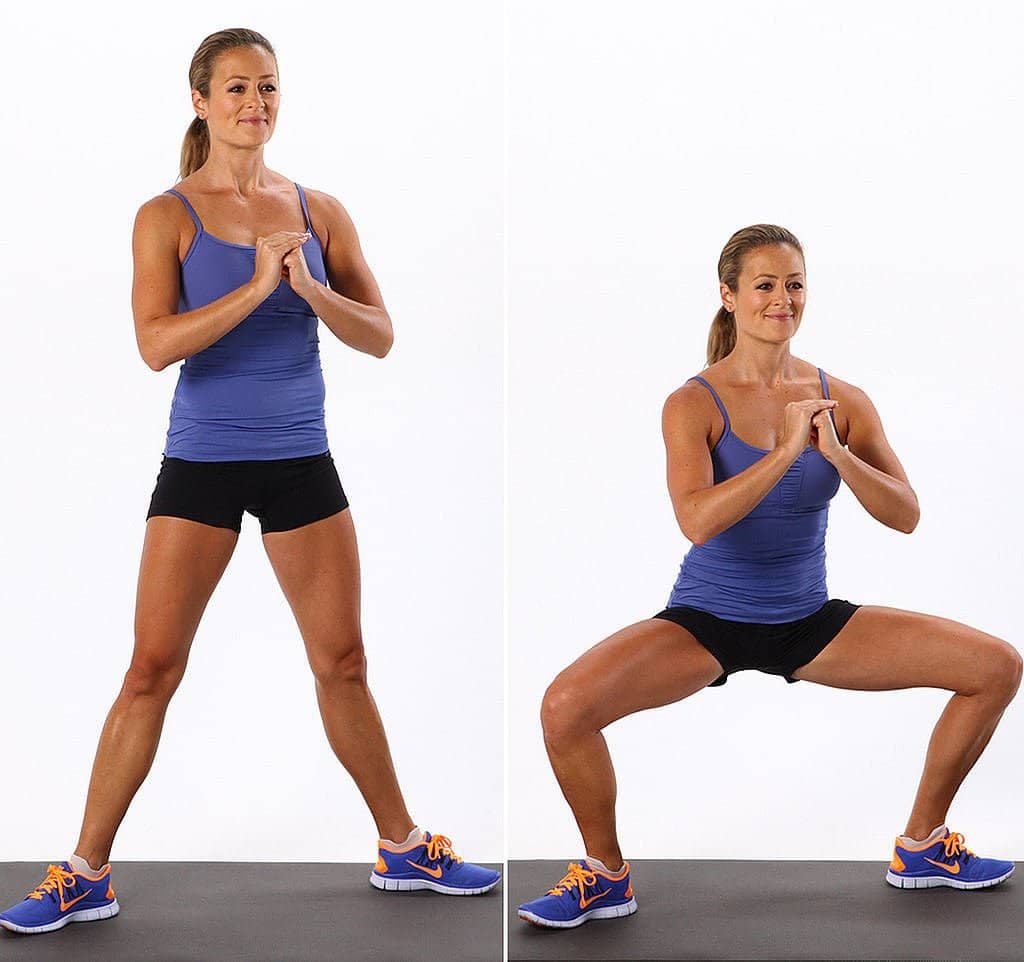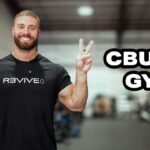Box squats are a great way to add more power and strength to your regular squat while also helping to improve your flexibility and mobility. In addition, box squats are a great accessory movement to add to your CrossFit training program. The box squat is a great compound exercise that you can implement into your workout routine. In this article, we are going to tell you what box squats are and how to do box squats. Also, we’ll cover box squats benefits and box squats form. Let’s get started. In this post, we’ll look at the box squat and how to achieve an ideal form while performing the box squat.
Jump to:
- What is the Box Squat?
- What are the benefits of box squats?
- What muscles do box squats build?
- How to achieve the perfect form (Box Squatting Technique)
- Box Squat Mistakes People Make
- Tips to improve your technique while box squatting
- Variations of the box squat
- Alternatives of the box squat
- Compare and Contrast Box squats with other squat techniques.
- How to Utilize Box Squats for CrossFit
- Equipment Needed
- Workout Example
- Box Squats Form: FAQs
What is the Box Squat?
The Box Squat is a squatting movement that athletes and fitness enthusiasts perform to improve their overall strength, explosiveness, and jumping ability. The Box Squat is a great exercise to improve an athlete’s speed, explosiveness, and jumping ability. The Box Squat is a versatile exercise with loads and intensities.
The Box Squat is a movement popularized by Olympic hammer thrower and powerlifter George Frenn in the 1960s. Box squats were later popularized by Louie Simmons and have since become a staple exercise for powerlifters and athletes using Louie Simons’ Westside Barbell Program.
What are the benefits of box squats?
Let’s talk about box squats benefits and what makes them different from the regular back and front squats. They offer many benefits and can help you to improve your overall fitness. Box squats are an excellent exercise for fitness newbies and CrossFitters. Here are the top 6 reasons why you should do the box squat exercise:
It Makes You Stronger
There is a major difference between standard squats and box squats. The back squat is just a very traditional eccentric followed by concentric kinetic chain movement. Basically, concentric is on the way up, and eccentric is on the way down. When performing the box squat, you break up the kinetic chain. Breaking up the eccentric and concentric phases is the most common reason to do the box squat. What does that mean?
You relax your hip flexors while keeping everything else tight. And then you pop back up into that concentric portion of the lift. Doing that static overcome by a dynamic type of movement is going to be completely different. Box squats are also a good choice if you are pregnant because they help build strength without putting too much stress on your body.
You pause on the box and then come back up. You’re getting no bounce. It will make you stronger in the long run. Learning to pop off the box will actually make your lower body muscles stronger than when you do free squats.
Perfect for Beginners
The box squat is not only a valuable tool to get stronger and more explosive but also a very valuable teaching tool, specifically for beginners who want to learn how to do a proper back squat. We recommend starting performing a box squat with light weights. Because hip tracking for lifters that are new to a squat is different. And they typically like to squat down instead of squatting back. You need to learn how to do the proper hip tracking that allows you to drive from your heels instead of your toes.
You can utilize the box squat routine to better learn and understand proper mechanics for squats as well as work on the weak points. It will help deliver a bigger squat deadlift and more muscularity.
More Weight
Box squats also allow you to lift more weight because you have the support of the box, which is beneficial for those looking to build muscle and increase their strength. You can add more weight and volume without worrying about injuries. So, not only is it a valuable tool to teach beginners but it’s also a way that you can perform far more volume without suffering the consequences of possibly overtraining. Box squats are a good option if you are injured because also they take the pressure off your joints.
Works the Posterior Chain
Box squats can help you build a solid and stable foundation for other exercises when performed correctly. By doing box squats regularly and increasing your range of motion, you can improve upon other movements such as the traditional squat and other lower body movements.
It’s a great way to get more of the back strength that you need. If you’re looking to build more powerful functional muscle mass, implement the box squat into your workout routine.
Less Pressure on the Knees
There is less pressure on your knees because more of the load is being placed on your glutes and hamstrings. This could be good if you’re trying to recover from an injury or you’re an older lifter and want to put less stress on your knees.
Depth
You can hit perfect squat depth every single time. This is very beneficial for a beginner who might not know what depth is; they have something to gauge their proper technique and gauge their depth.
Performing this exercise, beginners don’t squat high or too deep, losing control of the bar. Because they have to stop at the exact same spot every single time. And that’s why box squats can be a great tool not only to teach beginners depth but just to have the consistent depth for every single squat.
What muscles do box squats build?
Since the box squat is a compound functional strength movement, it targets a lot of muscle groups, including the back, glutes, hamstrings, and quadriceps. Generally, it’s a lower-body exercise.
You emphasize squatting with your posterior chain muscles. You’re not minimizing the quads, but you’re using your quads, hamstrings, and glutes in equal portions. In addition, the box squat is easier on the knees because of the pause in the middle of the movement.
Primary muscle groups:
Glutes, Hamstrings, Hips, and Back (Posterior Chain)
Secondary muscle groups:
Calves and hip adductors

How to achieve the perfect form (Box Squatting Technique)
To perform a box squat, set up a box or platform at about knee height, then lower yourself down onto it, keeping your feet flat on the ground and your back straight. Once you reach the box, pause before returning to the starting position. The box squat is very different from the standard squat. Many people think that it’s just a regular squat done on a box. But no, that is completely not true for many reasons. Let’s begin by analyzing the stance.
According to Westside Barbell, here are some proper techniques to get you started with the box squat.
Positioning
Position yourself so that your feet are as wide apart as possible. It’s not a closed stance or an Olympic-style squat. And most importantly, you are sitting all the way back and you’re shoving the knees out. If you were to attempt this in a free squat, you would fall straight on your glutes. This will help you use muscles in your back and hips to lift the weight.
Hand Positioning
Secondly, many people grab a barbell incorrectly. Get under the bar and tighten your core muscles to prepare for the lift. Finally, raise the bar from the rack. What you have to do is assume a wide stance. If you assume a wide stance, you will remove a lot of shoulder and elbow pain. Do not grab it with a thumb-under grip. It is a thumb-over grip. It will keep you safe.
Bar Height
Many people bring the bar too low or too high. If the barbell is too high, you can have trouble unwrapping it. If the bar is too low, you have to bend all the way down and you just lose all the explosive strength coming up. So, the barbell should be right in the middle of your chest.
Breathing
You may have heard this in the gym: exhale on exertion. This is completely wrong. If you try doing this on squats, you’re going to feel your lower back hurting a lot. And you’re going to get injured in the future, especially if you’re handling extremely heavy weights.
Here’s the proper way of doing it. Perform the Valsalva Maneuver while doing the box squats:
- Take a big belly breath. You don’t want your chest to expand, but you want your belly to get big. Whenever you perform the movement, you always want to have a deep breath. This keeps you safe. In the long term, it maximizes your performance.
- Close your glottis.
- Do the entire lift while exhaling against your closed glottis.
- After the exertion, let the air escape from your chest.
Foot Stance
With a box squat, you want a wide foot stance. Start by backing up for the closed stance and then gradually widen it. Your feet should be outside of your elbows.
Knees
Make sure your knees aren’t caving in and pop up out of the box. This helps work your glutes and strength which is definitely the hardest part of the squat for most people.
Relax your leg muscles
You are going to sit down on the box and relax your lower body muscles. Then pull back up. With standard squats, you’re simply using stretch, reflex, and bouncing back.
So, begin the eccentric phase by the hips first, not the knees. Push the hips and glutes rearward as you push your knees and feet out. This movement forces you to sit back not down. If you sit down, your quads will dominate.
The Proper Form:
- Push hips back, lower down with control;
- Minimize knee flexion;
- Pause for a count;
- Maintain torso position;
- Push through heels to explode back up.
Eccentric Phase (Down)
Bring your hips back first when you are lowering down to the box. This will ensure you use your glutes and hips to push down. Keep your head and chest up, and don’t forget to keep your core engaged until you are seated on the box.
Static Phase (Seated)
Keep your hip flexors relaxed, but tighten your back and leg muscles. While keeping your posterior chain muscles activated, keep a vertical shin so that they are straight up and down.
Concentric Phase (Up)
Time to explode off the box, repeating the movement pattern performed during the eccentric phase. Push off with your head first, then your glutes and hips.
Box Squat Mistakes People Make
Box squats are a great way to improve your strength and power, but people make some mistakes when doing them. Here are three of the most common ones:
1. One mistake is not maintaining tightness due to not keeping the core engaged.
This can cause you to round your back and strain your spine unnecessarily. Instead, keep your core engaged by pretending to crush a pop can with your abdominal muscles. This may help you remember to stay tight from the rack to the box and back.
2. Another mistake is not keeping your chest up and shoulders back.
This will cause you to lean forward and put more stress on your lower back.
3. Sitting on the box for too long is the third mistake.
When you are in the static phase of the box squat, your muscles start to relax. The hip adductors need to relax, but the posterior chain muscle groups working to sustain the weight need to stay tight. The longer you stay seated, the more exhausted your body will become, and you will revert to loosening up. Keep the proper muscles engaged and tight, so you don’t lose the momentum needed for the concentric phase of the exercise. Do not fail to use the deliberate pause to perform box squats better.
4. Another mistake is not using the correct height box.
If the box is too high, you won’t be able to get as low into the squat position. On the other hand, if it’s too low, you’ll put too much strain on your knees. So aim to keep the box at or just above parallel.
Avoiding these blunders when performing box squats will allow you to get the most out of the activity.
Tips to improve your technique while box squatting
If you are having trouble keeping your heels on the ground while doing the box squat, try placing two 5lb change plates on the floor just behind where your stance will be. Place your heels on the change plates and do a few air squats to the box to see if this will help you achieve proper form. You can also apply this to back squats.
Another option is to invest in some lifters. The specific style of shoes, referred to as lifters, has a unique design and shape to lift your heels off the ground. Lifters place your body in a better position to perform the squat. In addition, lifters can be helpful in other CrossFit movements such as squat snatches, squat cleans, back squats, and clean and jerks. Finally, lifters help you reach full range to perfect your next rep.
With the box squat, you can start small and work your way up to using a moderate weight. After that, you may want to begin practicing with a PVC pipe to get yourself prepared to perform the proper technique.

Variations of the box squat
Box squats, like any other CrossFit activity or movement, may be scaled to match the athlete’s needs. Starting with simple variations and gradually increasing in intensity as competence improves. Here are some options other than the standard box squat.
Weight Vest Box Squats
One box squat variation is to perform the exercise with a weight vest. This variation increases the exercise’s intensity and helps build strength and muscle mass. The accommodating resistance provided can also help with regular squats.
This variation is well suited for advanced athletes. Adding the weight vest can help you move past a strength plateau. You can test different box heights. Keep your chest high and shoulder blades back while box squatting with a weighted vest.
Banded-Box Squats
Another variation is to use bands. Bands increase the resistance and help to develop explosive power. Additionally, it can help to improve your form and technique. For example, banded box squats can help improve your range of motion and help you get into full range in different positions.

MedBall Box Squats
Finally, you can also perform the box squat with a medicine ball. This variation helps to develop core strength and stability. However, it also challenges your balance and coordination.
Alternatives of the box squat
The box squat is an excellent fitness tool that may help you increase your strength, power, and speed. However, some alternatives to the box squat can also help you achieve these exact results.
Goblet Squats
One box squat alternative is the goblet squat. This exercise involves holding a weight (usually a kettlebell) in front of your chest with both hands. You then squat down, keeping your back straight and your core engaged. The goblet squat can be a great alternative to the box squat because it can help to improve your balance and stability.

Sumo Squat
Another box squat alternative to the box squat is the sumo squat. This exercise is performed by spreading your feet wide apart and pointing your toes outwards. You then squat down, keeping your back straight and your core engaged. The sumo squat can be a great alternative to the box squat because it can help to improve your hip and leg strength.

Single-Leg Squat (Pistols)
Finally, another alternative to the box squat is the single-leg squat. Commonly referred to as ‘Pistols’ in CrossFit, this exercise is performed by standing on one leg and holding the other leg out in front of you. You then squat down, keeping your back straight and your core engaged. The single-leg squat can be a great alternative to the box squat because it can help to improve your balance and stability.

Compare and Contrast Box squats with other squat techniques.
There are a few different squat techniques that CrossFitters can use to target other muscle groups and achieve different results. Box squats are essential to your training routine because they help target the quads, glutes, and hamstrings while increasing stability and balance. Box squats require more coordination and balance than other squat variations because you must lower yourself onto a box or bench before squatting back up. This movement pattern forces you to use your lower body muscles more evenly, leading to better results. Box squats also tend to be more comfortable because they take pressure off your spine and lower back.
While box squats are a great exercise, they’re not the only squat variation. You can also try the traditional back squat, sumo squats, or jump squats. Each of these variations will work different muscles and produce different results. Mixing your squat routine to keep your body guessing and avoid plateauing is essential. So, if you want to add variety to your workout routine, consider giving box squats a try!
How to Utilize Box Squats for CrossFit
Box squats are a CrossFit staple for a good reason. They are a great way to increase your squatting strength and stability while teaching you how to stay tight during a squat. They are also a good accessory exercise for people who have trouble hitting depth in their squats and getting below parallel. The box squat is an excellent exercise for CrossFit athletes who want to improve their performance in movements that require quick, explosive movements like squat snatches, squat cleans, and coming out of the bottom of a back squat. Box squats can improve upon snatches and cleans with the box squat by teaching the lifter to keep their hips back and maintain a more upright posture throughout the movement. You should incorporate box squats in your workout program to build explosive strength.
Equipment Needed
To perform a box squat, you will need the following equipment:
- Enough space
- Box or bench
- Barbell, plate weights, dumbbell, kettlebell, medicine ball
Anyone can adapt the equipment above to suit your needs as an athlete.
Workout Example
Box Squats are an excellent exercise for both beginners and experienced CrossFitters alike.
Here is a sample workout to add to your next training session:
Three rounds of:
- 10 Box Jumps
- 10 Air Squats
Workout:
Three sets of 5 reps of Box Squats
- *Rest 1-2 minutes between sets
- *Start light and increase to heavier loads
Cool down:
3-5 minutes of light stretching or foam rolling.

Box Squats Form: FAQs
Are box squats as good as regular squats?
Box squats provide you with a lot of benefits:
- Engages more of the core;
- Helps with rapid force development;
- Can load the weight;
- Easier on the knees;
- Increases hip explosive strength;
- Increases strength in the 2nd half of a squat.
Are box squats as good as regular squats?
Box squats provide you with a lot of benefits:
Engages more of the core;
Helps with rapid force development;
Can load the weight;
Easier on the knees;
Increases hip explosive strength;
Increases strength in the 2nd half of a squat.
What are box squats good for?
If you are looking to build leg strength, box squats should be in your workout program. They definitely should be used as a tool to increase your strength and hypertrophy.
The box squat is beneficial because you get to develop a posterior chain in a very meaningful way. And because you are breaking up the eccentric and concentric chain, it builds explosive power like no other.














